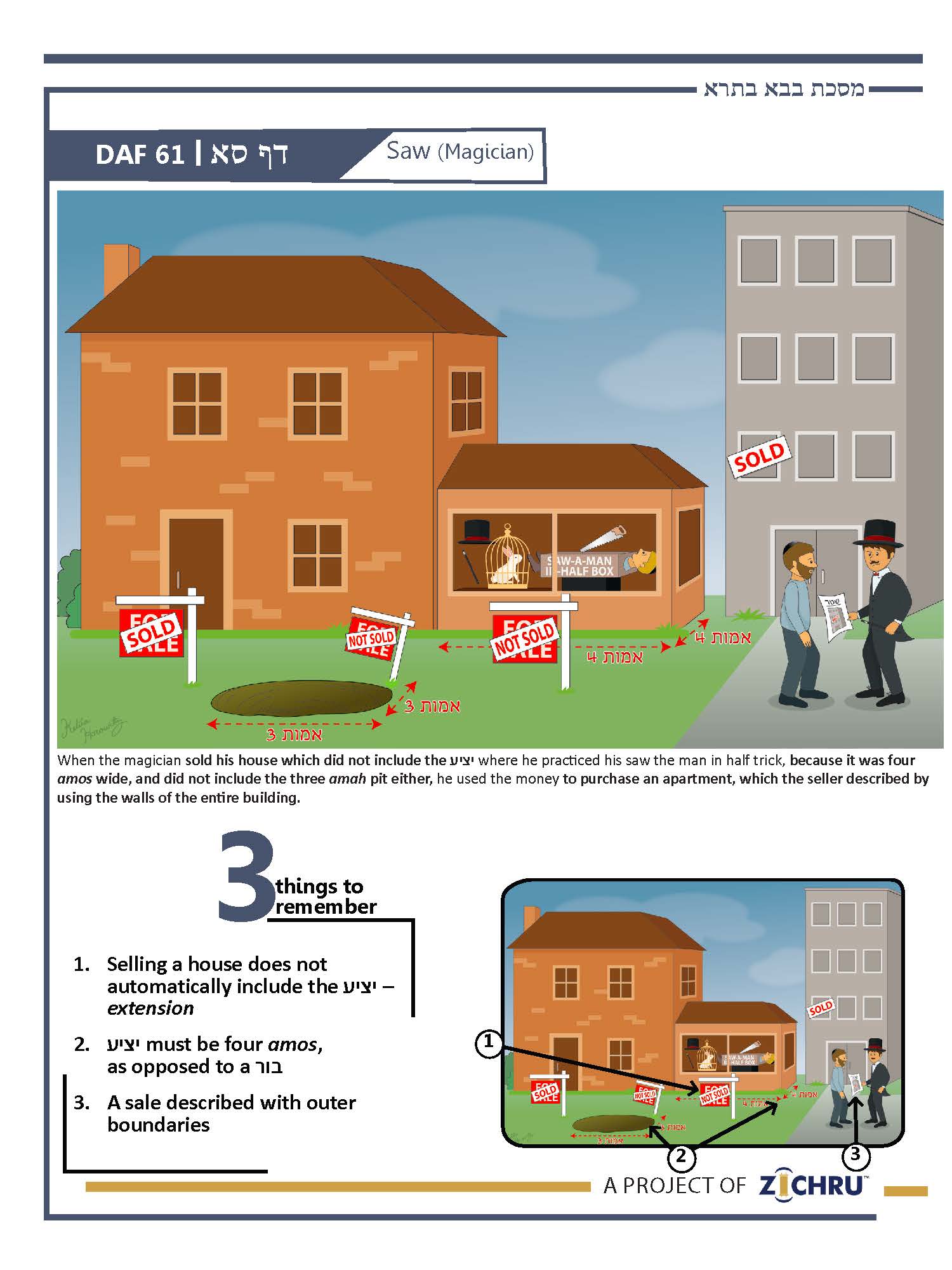Bava Basra - Daf 61
- Audio Timestamps
0:00 - The 3 Sugyos
2:41 - Review of 3 Sugyos
5:15 - Siman
7:47 - 4 Blatt Back Chazarah
13:50 - Pop Quiz (Last 7 blatt)
For access to all Zichru resources including PDFs, and illustrations CLICK HERE
- Selling a house does not automatically include the יציע – extension
The fourth Perek begins: המוכר את הבית לא מכר יציע – one who sells a house does not automatically sell the extension, ואף על פי שהיא פתוחה לתוכו – even if it opens into [the house]. He also has not sold the storeroom in the back of the house, nor the roof, if it has a ten-tefach fence around it. Rebbe Yehudah says that if there is a doorway to the roof, it is excluded from the sale even if its fence is shorter than ten tefachim. In Bavel, "יציע" was interpreted as "אפתא", a low building adjacent to the house, used for the same dwelling function as the house. Rav Yosef interpreted it as "בדקא חלילה", a similar structure with many windows, made for beautification and cooling off. According to the first opinion, that an אפתא is not sold with a house, then certainly a בדקא חלילה would not be sold. According to Rav Yosef, only a בדקא חלילה is not sold with a house, because it serves a different purpose than the house, but an אפתא would be included in the sale.
- יציע must be four amos, as opposed to a בור
Mar Zutra said: והוא דהוי ארבע אמות – This exclusion of the extension from the sale of the house is only if it is four square amos. If it is smaller, it is included in the sale. Ravina asked him that if so, the same should apply to the pit of a house. Yet, a Mishnah teaches that a pit is excluded from the sale of a house, although a standard pit is smaller than four amos!? The Gemara answers that the cases are different: התם הא תשמישתא לחוד והא תשמישתא לחוד – there, [the house] has its own function, and [the pit] has its own function. Since they serve different purposes, the pit is not included in the house’s sale, even if it is smaller than four amos. הכא אידי ואידי חדא תשמישתא היא – Here, both [the house and the extension] have essentially the same purpose, as a living area. Therefore, only if it is four square amos is it considered independently significant and excluded from the house’s sale.
- A sale described with outer boundaries
Rav Nachman said that if one sold a house in a בירה גדולה – a large apartment building, אף על פי שמצר לו מצרים החיצונים – even if he described (in the שטר) the boundaries of the property with the outer boundaries of the entire building, מצרים הרחיב לו – we say he merely widened the boundaries for him to identify the building, and not that he sold the entire building. The Gemara asks that if the local practice is to call a single house a “house,” and an apartment building a "בירה", not a “house,” Rav Nachman’s ruling would be obvious. If everyone does call an apartment building a “house,” then the entire building should be sold, since the outer boundaries were recorded in the שטר!? Rather, the case is where most people use the word "בירה", and not “house,” for a building, but some do call it a house. Rav Nachman teaches that since the seller should have written: ולא שיירית בזביני אלין כלום – “I did not retain anything in this sale for myself,” and he did not, it indicates that he did not sell the entire building.
Rav Nachman ruled the same way with a field sold inside a large plain, where the seller used the boundaries of the entire plain. The Gemara explains the ruling the same way and explains the novelties of the two rulings.
Siman – Saw (Magician doing the saw-a-person-in-half trick)
When the magician sold his house which did not include the יציע where he practiced his saw-the-man-in half trick, because it was four amos wide, and did not include the three-amah pit either, he used the money to purchase an apartment, which the seller described by using the walls of the entire building.


